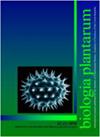镉胁迫对茶树抗坏血酸谷胱甘肽途径和抗坏血酸再生的影响
IF 0.9
4区 生物学
Q4 PLANT SCIENCES
引用次数: 0
摘要
抗坏血酸(AsA)和谷胱甘肽(GSH)在非生物胁迫下有助于防御反应。本研究探讨了高浓度(30mM)镉对茶树(Camellia sinensis L.)抗坏血酸谷胱甘肽循环和抗坏血酸再生的影响。Cd处理后第7天,叶片中的超氧阴离子(O2.-)和过氧化氢(H2O2)含量显著升高。O2.-的含量H2 O2在第5天最高(分别为对照的212.7%和153.6%)。镉处理后第1天AsA含量增加(86.9%),随后几天显著下降,而GSH则呈相反趋势。酶活性测定表明,镉叶面施用后,参与AsA再生的脱氢抗坏血酸还原酶(DHAR)和谷胱甘肽还原酶(GR)显著下调。相反,抗坏血酸过氧化物酶(APX)和单脱氢抗坏血酸还原酶(MDHAR)的活性在第一天增加,然后下降。逆转录定量PCR显示AsA再生途径的谷胱甘肽合成酶(CsGSHS)、γ-谷氨酰半胱氨酸合成酶(Csγ-ECS)和CsMDHAR上调,CsDHAR和CsGR下调。L-半乳糖途径的GDP-L-半乳糖磷酸化酶(CsGGP)、L-半乳糖-1-磷酸磷酸酶(CsGPP)和L-半乳糖-1,4-内酯脱氢酶(CsGaILDH)的表达也下调。结果表明,AsA可通过提高抗氧化能力来应对植物的镉胁迫,其被消耗来清除ROS;此外,镉胁迫抑制了AsA的合成和再生,使茶树受到严重的伤害。本文章由计算机程序翻译,如有差异,请以英文原文为准。
The impact of cadmium stress on the ascorbate-glutathione pathway and ascorbate regeneration in tea plants
Ascorbic acid (AsA) and glutathione (GSH) contribute to defense responses under abiotic stresses. The present study explored the ascorbate-glutathione cycle and ascorbate regeneration under high concentration (30 mM) of cadmium in the tea plant ( Camellia sinensis L.). The tea leaves showed speckles and necrosis from the third day of Cd treatment. The content of superoxide anion (O 2 . - ) and hydrogen peroxide (H 2 O 2 ) in the leaves were significantly higher until the seventh day after Cd treatment. The content of O 2 . - and H 2 O 2 were the highest on the fifth day (212.7 and 153.6 % of the control, respectively). The AsA content increased (86.9 %) on the first day after Cd treatment and decreased significantly in the subsequent days, while GSH showed a reverse trend. The enzymatic activity assays showed that dehydroascorbate reductase (DHAR) and glutathione reductase (GR) involved in AsA regeneration were downregulated considerably after Cd foliar application. In contrast, the activities of ascorbate peroxidase (APX) and monodehydroascorbate reductase (MDHAR) increased on the first day and then declined. Reverse-transcription quantitative PCR showed upregulation of glutathione synthetase (CsGSHS), γ-glutamylcysteine synthetase (Csγ-ECS), and CsMDHAR of the AsA regeneration pathway and downregulation of CsDHAR and CsGR. The expressions of GDP-L-galactose phosphorylase (CsGGP), L-galactose-1-phosphate phosphatase (CsGPP), and L-galactono-1,4-lactone dehydrogenase (CsGaILDH) of the L-galactose pathway were also downregulated. The results indicated that AsA, which can respond to Cd stress of plants by increasing antioxidant ability, was consumed to scavenge ROS; moreover, Cd stress inhibited AsA synthesis and regeneration, which made that tea plants suffering severe damage.
求助全文
通过发布文献求助,成功后即可免费获取论文全文。
去求助
来源期刊

Biologia Plantarum
生物-植物科学
CiteScore
2.80
自引率
0.00%
发文量
28
审稿时长
3.3 months
期刊介绍:
BIOLOGIA PLANTARUM is an international journal for experimental botany. It publishes original scientific papers and brief communications, reviews on specialized topics, and book reviews in plant physiology, plant biochemistry and biophysics, physiological anatomy, ecophysiology, genetics, molecular biology, cell biology, evolution, and pathophysiology. All papers should contribute substantially to the current level of plant science and combine originality with a potential general interest. The journal focuses on model and crop plants, as well as on under-investigated species.
 求助内容:
求助内容: 应助结果提醒方式:
应助结果提醒方式:


